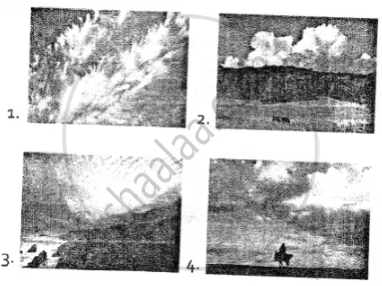Advertisements
Chapters
2: Scale and Distance
3: Composition and Structure of the Atmosphere
4: Greenhouse Effect and Global Warming
5: Study of Weather
▶ 6: Recording of Weather
7: Types of Rocks
8: Weathering and Soil
9: Industries: Their Need, and Classification
10: Major Industries
11: Renewable and Non-renewable resources
12: Europe: Location, Area, Political & Physical Features
13: Europe: Climate, Natural Vegetation, Wildlife; Forest, Minerals & Power Resources
14: Africa: Location, Area, Political & Physical Features
15: Africa: Climate, Natural Vegetation, Wildlife; Minerals
16: Australia:Location,Area, Political & Physical Features
17: Australia: Climate, Natural Vegetation, Wildlife; Forest and Minerals
18: Antarctica: Location, Physical Features, Climate, Natural Vegetation
![Oxford University Press solutions for Voyage Geography [English] Class 7 chapter 6 - Recording of Weather Oxford University Press solutions for Voyage Geography [English] Class 7 chapter 6 - Recording of Weather - Shaalaa.com](/images/voyage-geography-english-class-7_6:4256ba090345470c9fead663b561899f.jpg)
Advertisements
Solutions for Chapter 6: Recording of Weather
Below listed, you can find solutions for Chapter 6 of CISCE Oxford University Press for Voyage Geography [English] Class 7.
Oxford University Press solutions for Voyage Geography [English] Class 7 6 Recording of Weather Discuss
How are dewdrops beneficial for plants?
Oxford University Press solutions for Voyage Geography [English] Class 7 6 Recording of Weather Answer the questions in brief
What is relative humidity? How does it differ from absolute humidity?
What does a large difference between the temperatures of a dry bulb thermometer and a wet-bulb thermometer of a hygrometer indicate?
Differentiate between precipitation and condensation. Give one example of each.
What are nimbus clouds?
What is the Beaufort scale?
Oxford University Press solutions for Voyage Geography [English] Class 7 6 Recording of Weather Answer the questions in one or two paragraphs
What is a hygrometer?
Describe the various types of clouds.
What is wind? What precautions must be taken while placing a wind vane?
What are the isohyets and isotherms?
What is the weather report?
How is the weather forecast made? Why is weather forecast necessary?
Oxford University Press solutions for Voyage Geography [English] Class 7 6 Recording of Weather Exercise 1
For a week, gather information on the weather conditions of your city using simple instruments or from weather reports published in newspapers. Present this information in a table. One has been done for you here. My observation of the weather for a week.
| Weather Conditions | |||
| Day | Date | Morning | Evening |
| Tuesday | 1.5.2017 | Sunny, clear sky, warm, no rainfall | Cloudy, cold, slight drizzle |
Oxford University Press solutions for Voyage Geography [English] Class 7 6 Recording of Weather Exercise 2
This could be a classroom activity. If your school laboratory has an anemometer, use it to record your city’s wind speed for a week. Use the Beaufort Scale to find out the character of wind during these days. Record your observations carefully in your notebook. You could even draw small neat sketches to show the effect of the wind.
Oxford University Press solutions for Voyage Geography [English] Class 7 6 Recording of Weather Exercise 3
From the weather report published in your local newspaper, record the time of sunrise and sunset for a month in your notebook, as shown below: My observation of the time of sunrise and sunset for the month of ______ 20, ______
| Date | Time of sunrise | Time of sunset | Calculation of length of the day |
| 10 June 2017 | 5.24 a.m. | 5.51 p.m. | 12 hours and 27 minutes |
Oxford University Press solutions for Voyage Geography [English] Class 7 6 Recording of Weather Picture Study

- Identify the four types of clouds shown in the photographs.
- Which of these causes heavy rainfall?
Solutions for 6: Recording of Weather
![Oxford University Press solutions for Voyage Geography [English] Class 7 chapter 6 - Recording of Weather Oxford University Press solutions for Voyage Geography [English] Class 7 chapter 6 - Recording of Weather - Shaalaa.com](/images/voyage-geography-english-class-7_6:4256ba090345470c9fead663b561899f.jpg)
Oxford University Press solutions for Voyage Geography [English] Class 7 chapter 6 - Recording of Weather
Shaalaa.com has the CISCE Mathematics Voyage Geography [English] Class 7 CISCE solutions in a manner that help students grasp basic concepts better and faster. The detailed, step-by-step solutions will help you understand the concepts better and clarify any confusion. Oxford University Press solutions for Mathematics Voyage Geography [English] Class 7 CISCE 6 (Recording of Weather) include all questions with answers and detailed explanations. This will clear students' doubts about questions and improve their application skills while preparing for board exams.
Further, we at Shaalaa.com provide such solutions so students can prepare for written exams. Oxford University Press textbook solutions can be a core help for self-study and provide excellent self-help guidance for students.
Concepts covered in Voyage Geography [English] Class 7 chapter 6 Recording of Weather are Elements of Weather, Difference Between Weather and Climate, Weather Instruments, Isohytes and Isotherms.
Using Oxford University Press Voyage Geography [English] Class 7 solutions Recording of Weather exercise by students is an easy way to prepare for the exams, as they involve solutions arranged chapter-wise and also page-wise. The questions involved in Oxford University Press Solutions are essential questions that can be asked in the final exam. Maximum CISCE Voyage Geography [English] Class 7 students prefer Oxford University Press Textbook Solutions to score more in exams.
Get the free view of Chapter 6, Recording of Weather Voyage Geography [English] Class 7 additional questions for Mathematics Voyage Geography [English] Class 7 CISCE, and you can use Shaalaa.com to keep it handy for your exam preparation.
